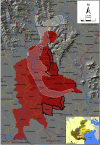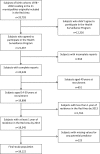Serum Levels of Perfluoroalkyl Substances (PFAS) in Adolescents and Young Adults Exposed to Contaminated Drinking Water in the Veneto Region, Italy: A Cross-Sectional Study Based on a Health Surveillance Program
- PMID: 32068468
- PMCID: PMC7064325
- DOI: 10.1289/EHP5337
Serum Levels of Perfluoroalkyl Substances (PFAS) in Adolescents and Young Adults Exposed to Contaminated Drinking Water in the Veneto Region, Italy: A Cross-Sectional Study Based on a Health Surveillance Program
Abstract
Background: In spring 2013, groundwater of a vast area of the Veneto Region (northeastern Italy) was found to be contaminated by perfluoroalkyl substances (PFAS) from a PFAS manufacturing plant active since the late 1960s. Residents were exposed to high concentrations of PFAS, particularly perfluorooctanoic acid (PFOA), through drinking water until autumn 2013. A publicly funded health surveillance program is under way to aid in the prevention, early diagnosis, and treatment of chronic disorders possibly associated with PFAS exposure.
Objectives: The objectives of this paper are: a) to describe the organization of the health surveillance program, b) to report serum PFAS concentrations in adolescents and young adults, and c) to identify predictors of serum PFAS concentrations in the studied population.
Methods: The health surveillance program offered to residents of municipalities supplied by contaminated waterworks includes a structured interview, routine blood and urine tests, and measurement of 12 PFAS in serum by high-performance liquid chromatography-tandem mass spectrometry. We studied 18,345 participants born between 1978 and 2002, 14-39 years of age at recruitment. Multivariable linear regression was used to identify sociodemographic, lifestyle, dietary, and reproductive predictors of serum PFAS concentrations.
Results: The PFAS with the highest serum concentrations were PFOA [median , interquartile range (IQR) 19.3-84.9], perfluorohexanesulfonic acid (PFHxS) (median , IQR 1.9-7.4), and perfluorooctanesulfonic acid (PFOS) (median , IQR 2.6-5.8). The major predictors of serum levels were gender, municipality, duration of residence in the affected area, and number of deliveries. Overall, the regression models explained 37%, 23%, and 43% of the variance of PFOA, PFOS, and PFHxS, respectively.
Conclusions: Serum PFOA concentrations were high relative to concentrations in populations with background residential exposures only. Interindividual variation of serum PFAS levels was partially explained by the considered predictors. https://doi.org/10.1289/EHP5337.
Figures


References
-
- Ballesteros V, Costa O, Iñiguez C, Fletcher T, Ballester F, Lopez-Espinosa MJ. 2017. Exposure to perfluoroalkyl substances and thyroid function in pregnant women and children: a systematic review of epidemiologic studies. Environ Int 99:15–28, PMID: 27884404, 10.1016/j.envint.2016.10.015. - DOI - PubMed
Publication types
MeSH terms
Substances
Grants and funding
LinkOut - more resources
Full Text Sources
Other Literature Sources

